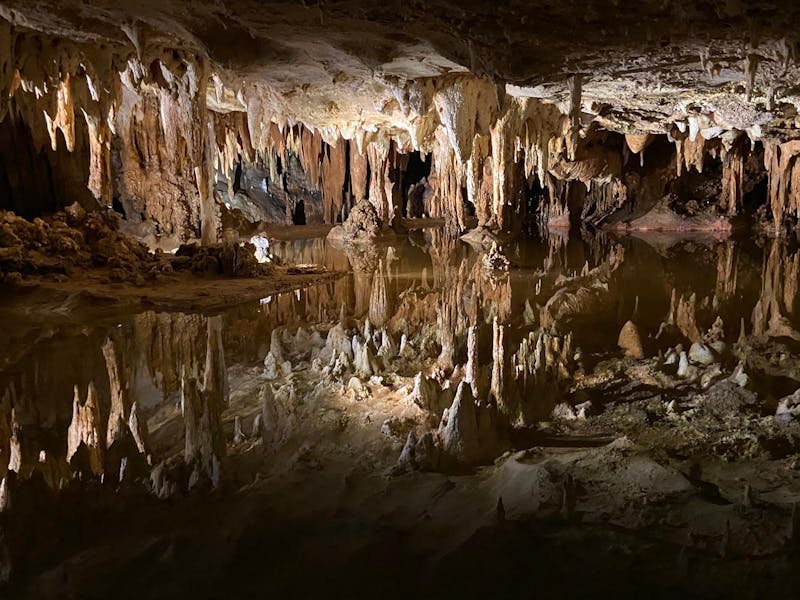
COURTESY OF BINYAMIN NOVETSKY
Over fall break, Novetsky visited the Luray Caverns in Virginia, which reminded him of one of his favorite Dickinson poems.

COURTESY OF BINYAMIN NOVETSKY
Over fall break, Novetsky visited the Luray Caverns in Virginia, which reminded him of one of his favorite Dickinson poems.
I took a class this semester on Emily Dickinson for a very simple reason: I, like many people my age, was really into John Green in high school. Green, who is really into Dickinson, introduced me to what has been my favorite poem since 2014 — “‘Hope’ is the thing with feathers.” And since that was my favorite poem, I thought a class entirely about Dickinson might be kind of neat. So here I am.
For those who don’t know, Dickinson can primarily be identified in two distinct yet related ways. She was, first and foremost, an absolute genius. Her control of the English language is beyond remarkable, and the emotional power she can eke out of just a few words is astounding. Secondly, Dickinson was rather bizarre. She spent the vast majority of her life in the same room in her house, and most of that time she was either looking out her window at nature, writing poems or writing poetry about the nature she was looking at outside her window.
Dickinson’s poetry is many things. In fact, thematic diversity is one of the most interesting aspects of her poetry. Most of what she wrote, though, couldn’t exactly be classified as “joyful.” And yet, somehow, when thinking about what brings me joy nowadays, she kept popping up in my mind.
I can hardly read the aforementioned “Hope” poem without my voice cracking, and I even got a bad grade on a paper about that very poem because I was so emotionally into it that I forgot to actually do a good job writing about it. But Dickinson has substantially changed the way that I view the world around me for more reasons than just that.
Over fall break, I visited the Luray Caverns in Virginia. They’re amazing — truly a natural phenomenon capable of taking your breath away. The whole time I couldn’t help but think back to a poem I would later write a full essay about, “Before I got my eye put out” (and yes, there is in fact a Crash Course video with Green focusing on that poem in particular).
In the poem Dickinson talks about how, although she is blind (she never was, by the way), she wishes she could see the world around her again. She doesn’t just want to see it, though. She wants to own it. To put it in her words, “The Meadows — mine — / The Mountains — mine —.”
As I stood there literally under a mountain, surrounded by pillars of stone so intricate they hardly seemed natural and curtains of rock so thin that light shone through them, I thought about how Dickinson would have looked at them and said, “Yeah, you know what, this is mine now.”

Now, granted, Dickinson never left Massachusetts, so she definitely never got to see the Luray Caverns (though she did write a poem about a cavern). But had she, I can only imagine how she would have written about them, how she would have conveyed their natural beauty in a way that nobody else could. Seeing the natural wonder of the caverns, all I wanted was to know what Emily would think.
I have no intention of attempting to purchase any aspect of nature — frankly, I can’t afford it. But Dickinson makes me wonder what kind of mind it takes to look at the world and see its beauty so completely that a person would then want to possess it themselves, to hold it in the palm of their hand.
To me, that’s joy.
That said, most of us don’t get to go outside very often anymore. I probably won’t go on another hike until spring at least, and with the pandemic raging and the weather getting colder, I’m finding it likely that I’ll be spending a significant amount of time indoors for the foreseeable future. I might even spend the vast majority of that time in just one room.
I won’t suggest that just because Dickinson did it for years, we can all do it for a few months. That’s ridiculous. Being so locationally limited is hard. I’m (probably) not as bizarre as Dickinson was, and I’m definitely nowhere near as much of a genius. Taking inspiration from her doesn’t make this situation easy. And yet Dickinson’s words come back to me again, this time from when she once pulled her niece into her bedroom, locked the door and then told her that “this is freedom.”
We are not living in particularly joyful or free times. But I consistently catch myself finding joy in the words of Dickinson. Her poetry moves me, her life confuses me, but it’s all still fun for me, somehow. It can be hard at times to know what she’s saying — some of her poetry is so dense it reads more like a literary shopping list than a coherent set of ideas. And yet no matter how bad things get, I always remember that hope isn’t the thing with feathers, but “hope” is. She put those quotation marks there for a reason. We don’t need concrete reasons to find hope for it to uplift us. The only thing we need is the knowledge that somewhere out there it exists. Hope itself may temporarily elude us, but the very concept of it “never stops — at all —.”
There’s nothing that brings me joy like hope, and there’s no one who brings me hope like Emily Dickinson.